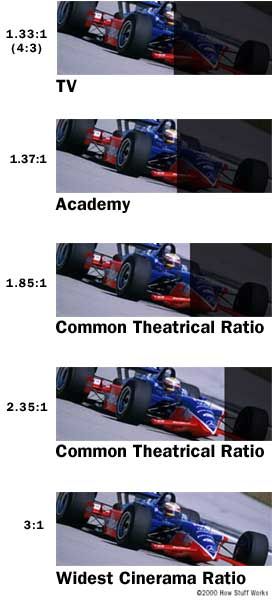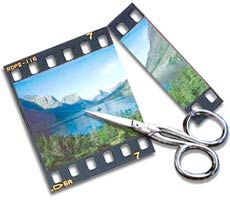No matter how it was filmed, the best way to present a movie on video as it was originally created is to letterbox it. This format presents the full, wide picture on the middle of the television screen, with black bars above and below it. This maintains the movie's original theatrical aspect ratio, so that you see everything the director intended you to see. Because they preserve the original cinematography of the movie, letterbox, or widescreen, videos have become more and more popular in recent years. The format is particularly common on DVDs because their increased storage capacity can hold both a letterbox version and a full-frame version, a presentation that uses the entire television screen. Also, their increased picture quality helps counteract the loss of resolution caused by shrinking the movie picture.
The problem with letterboxing is that it shrinks the viewing area of the television screen, which, if you have a small set to begin with, can make it fairly difficult to see the movie. For this reason, letterboxing is not the most popular formatting option. Most viewers are bothered by the black bars at the top and bottom of their screen more than they are bothered by the idea of not seeing the picture as it was originally filmed, so full-frame movie presentations are much more prevalent than letterbox presentations. But if you are a student of film and want to fully experience the movie as a work of art, then the letterbox format is the only way to go.
Squeezing & Cropping
Squeezing & Cropping
If a movie was filmed using an anamorphic lens, then the complete picture already exists in a 1.37:1 format and so can be shown full frame on a television without cutting much of the image. The problem, of course, is that this image is severely squeezed, so that circles appear to be eggs and everyone's face is creepily elongated. Most viewers find this distracting, to say the least, so this formatting option is not used very often. Some video producers did release movies this way when home video was just starting out, but these days, the only time you're likely to see this is at the beginning of movies, as a means of fitting wide opening credits on the screen. The more popular option in recent years has been to letterbox the opening credit sequence
Another method from the early days of home video is cropping. This term is sometimes used generally to describe cutting off part of the original theatrical picture, but it also refers to one specific formatting method. In this original cropping technique, the video formatter simply presents the middle part of the theatrical picture on video. Cropped movies frequently have rotten cinematography and can actually be hard to follow. This is because the technique blindly ignores anything that happens on the side of the screen, playing the odds that most of the important action will appear in the middle of the screen, at least in part. If a minor character only shows up on the far left side of a wide-aspect ratio shot, then he may not even show up in the cropped edition of the movie. A particularly maddening scenario is when two characters in conversation stand on either side of the picture. The viewer sees the entire conversation with only the very edge of each person's face appearing on their screen, and nothing but blank space taking up the rest of the picture. Fortunately, this technique has mostly fallen by the wayside.
Pan & Scan
Pan & Scan
The method that has mostly replaced cropping and squeezing is panning and scanning. In this process, a video technician views the movie with its original aspect ratio and decides which television-sized chunk of the movie to show at any one time. Usually, this means focusing on the elements of the picture that are most important to the plot, which is obviously a subjective decision. If you have two characters at either end of a widescreen shot, for example, the pan-and-scan operator must decide which one to show. The operator will probably show the one that is talking, or performing the more conspicuous action. A careful pan-and-scan operator will try to represent the different important aspects of a shot by "cutting" between the two halves of the screen, so that what was originally one shot becomes multiple shots. The operator can also create a pan from one side of the picture to another (hence the name of the process).
To see what you might miss when a movie scene has been panned and scanned, click several times on the left or right arrow.
If a movie was shot with an anamorphic lens or a hard matte, the two main formatting options are to letterbox the movie or pan and scan it. If the movie was shot using a soft matte, however, there is a third option.
Open Matte
We know that a filmmaker using a soft matte exposes the entire film area when shooting a movie. If 35mm film is used, this full image has an aspect ratio of 1.37:1, fairly close to television's 1.33:1 aspect ratio. One formatting solution is to leave the matte "open," making the video copy of the movie from this entire film area. The picture then fills the entire television screen and only crops a small amount from the sides of the filmed image.
The success of this method depends on how the director shot the movie. Some directors compose each shot with both the soft-matted picture and the full image in mind. When they look through the camera, they see the entire picture exposed to the film and a superimposed rectangle indicating the theatrical aspect ratio. In this case, the main thing you lose in video formatting is visual composition. So if you are mainly interested in following the plot of a movie, and not so much in cinematography, a full-frame version of a soft-matted movie will probably suit you fine. A full-frame picture of this sort doesn't cut out much visual information, so you aren't as likely to miss details or plot points as you are watching a panned and scanned version of an anamorphic or hard-matted movie.
The full-frame picture of a soft-matted movie is not always usable, however. A lot of directors will use a soft matte but completely ignore what's outside the theatrical matte. If you take a full image from this sort of movie, you might very well see boom mikes, lights and unfinished sets. Also, if the movie includes special visual effects, there's a good chance they were added only to the theatrical aspect ratio portion of the image. It might be that some shots are usable and some are not. In this case, the video formatter may choose to combine full-frame shots with panning and scanning of the soft-matted theatrical picture.
For more information on video formatting and related topics, check out the links on the next page.

